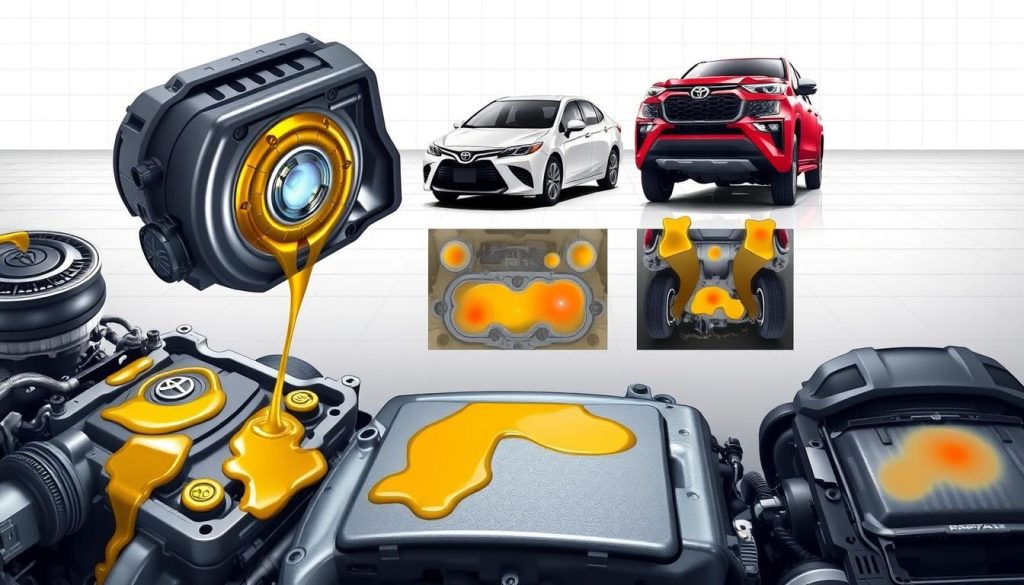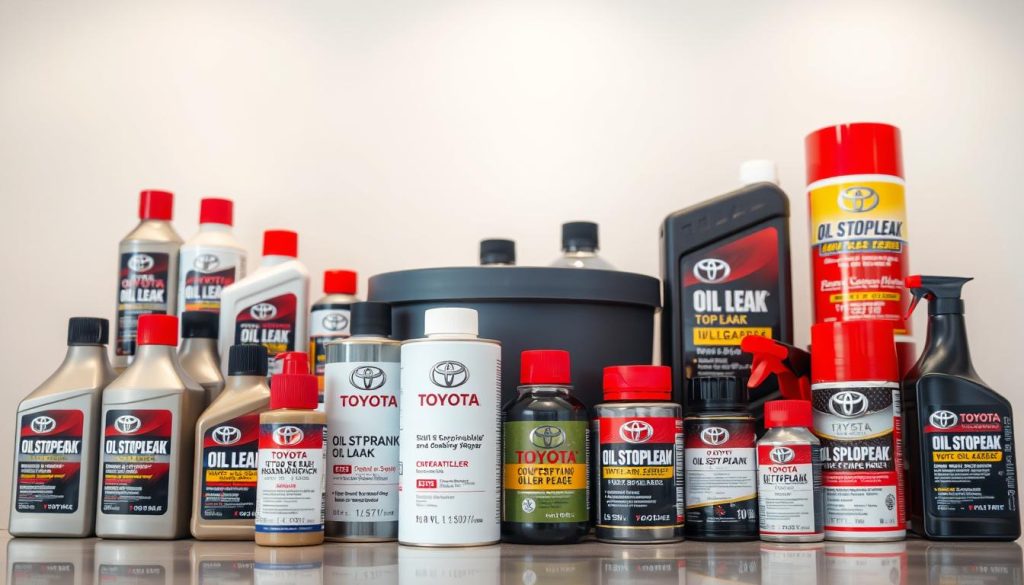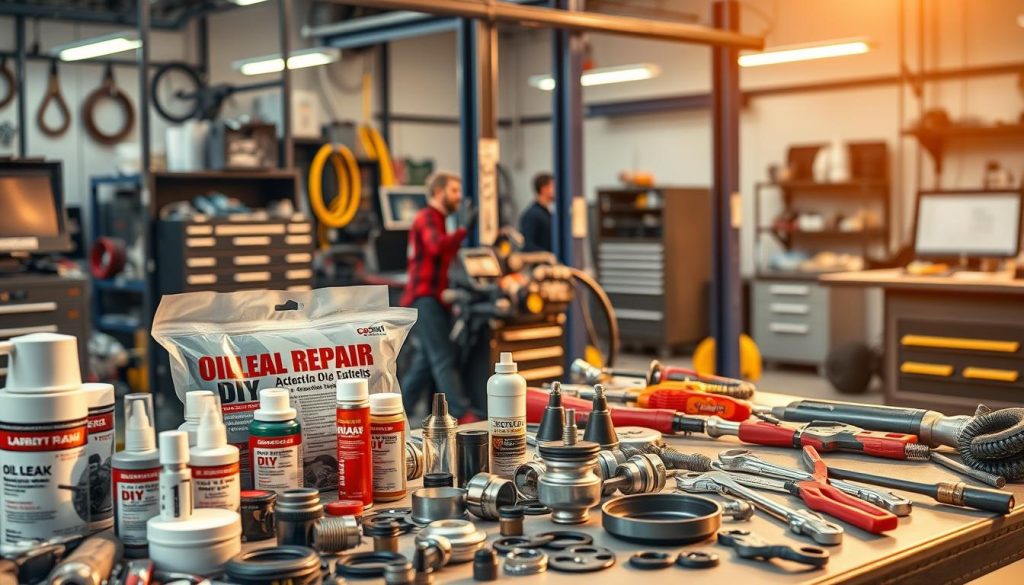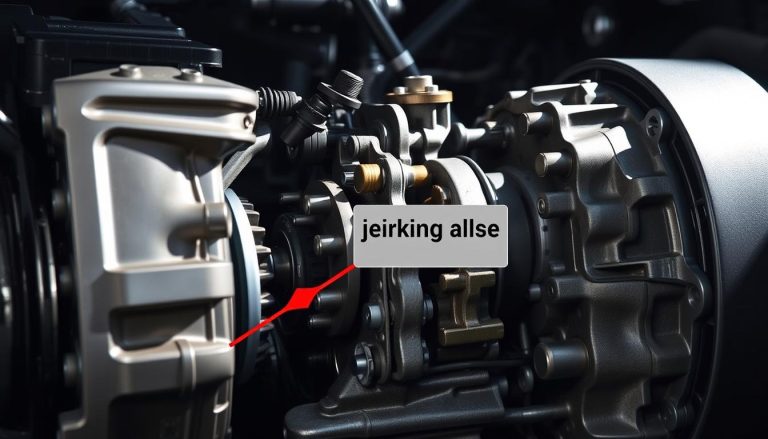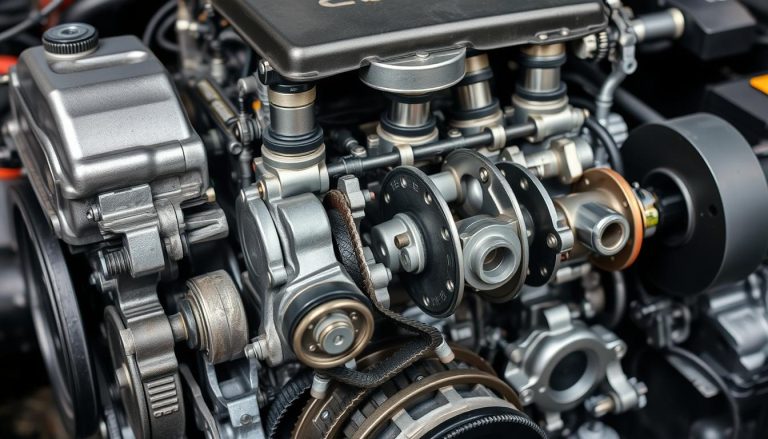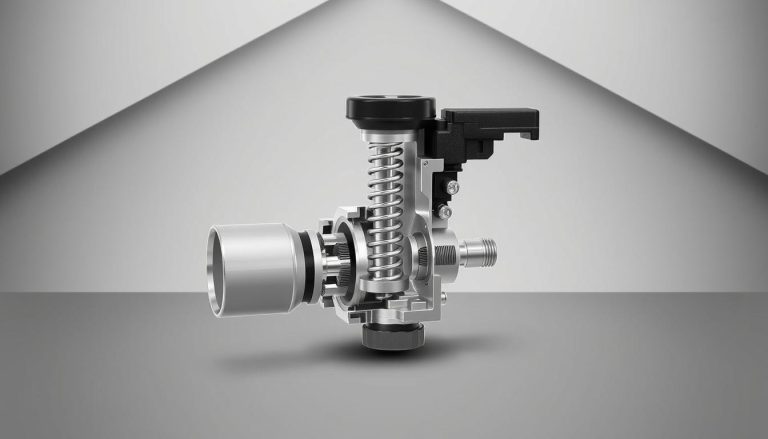Toyota Oil Leak: Common Causes and Repair Options
Engine fluid leaks are a common problem for car owners. They happen to many drivers in the U.S. each year. Ignoring small leaks can lead to big mechanical failures.
Not fixing these issues can cause more than just trouble. It can make your engine wear out fast. This can lead to expensive repairs and safety risks.
Knowing why leaks happen and how to fix them helps you take care of your car. This guide will show you how to spot problems and get them fixed. We’ll also talk about Toyota maintenance to avoid big repairs and keep you safe.
Key Takeaways
- Engine fluid leaks can cause rapid deterioration and expensive damage if ignored
- Early detection and prompt action prevent minor issues from becoming major problems
- Multiple mechanical factors contribute to automotive fluid loss in vehicles
- Professional diagnosis helps identify the most cost-effective repair solutions
- Regular maintenance schedules significantly reduce the risk of serious engine problems
- Safety concerns make timely intervention critical for both vehicle and driver protection
Understanding Oil Leaks in Toyota Vehicles
Toyota engines leak oil when their seals wear out over time. These Toyota oil leak causes come from the engine’s gaskets, seals, and joints. These parts keep the oil inside the engine block.
Your Toyota’s engine is like a closed system. Oil flows through it in many paths. It needs several key seals to keep oil pressure right and stop leaks:
- Oil pan gasket at the bottom of the engine
- Valve cover gaskets on top of the cylinder head
- Timing cover seals around the front of the engine
- Oil filter housing connections
- Various shaft seals and O-rings throughout the system
Even though Toyotas are known for being reliable, they can have automotive oil problems as they get older. Heat from driving makes rubber seals crack. Engine vibrations loosen gasket connections over time.
Knowing the difference between small engine oil seepage and big leaks helps you decide what to do. A few drops under your car after it sits might just be minor seepage. But if you see a lot of oil or your oil level drops fast, you need to act fast.
Extreme temperatures also hurt seals. Cold makes rubber brittle, and heat makes seals expand and contract. This happens to all cars, not just Toyotas.
Understanding these basics helps you fix oil leaks before they damage your engine. Catching problems early and keeping up with maintenance keeps your Toyota running well for a long time.
Identifying Signs of a Toyota Oil Leak
Spotting oil leak symptoms early can save you a lot of money on repairs. Keeping an eye on your car’s health is key. Most leaks start small and get bigger over time.
Look for oil spots under your car, even small ones. If your car uses more oil than usual, it might be leaking. Sometimes, the engine oil light on your dashboard will turn on.
Visual Indicators Under Your Vehicle
Fluid under your car is a clear sign of an oil leak. Fresh oil is dark brown or black and feels oily. Older leaks can leave dark stains on the ground.
Each car fluid looks and feels different. Here’s a table to help you tell oil apart from other fluids:
| Fluid Type | Color | Consistency | Location |
|---|---|---|---|
| Engine Oil | Dark brown/black | Thick, slippery | Center/front of vehicle |
| Transmission Fluid | Red/pink | Thin, sweet smell | Center of vehicle |
| Coolant | Green/orange | Watery, sweet smell | Front of vehicle |
| Power Steering | Red/amber | Oily texture | Front left/right |
Engine Performance Symptoms
Engine oil warning signs can show up in how your car runs. You might hear strange noises when starting or speeding up. These sounds mean your engine isn’t getting enough oil.
When your car doesn’t accelerate well, it could be leaking oil. You might also notice your car uses more oil than usual. Some people smell burning oil, which is a bad sign.
Dashboard Warning Signs
Modern Toyotas have systems to catch leaks early. The oil pressure light is the most important warning. If it turns red, you need to check your car right away.
Oil level lights on your dashboard can flash more often if there’s a leak. Some Toyotas show oil life percentages that go down fast. Don’t ignore these lights—they’re trying to tell you something.
Essential Tools and Safety Equipment for Oil Leak Repairs
Before you start fixing a Toyota oil leak, make sure you have the right oil leak repair tools and automotive safety equipment. This ensures your repairs are done right and keeps you safe. Getting ready ahead of time can make a big difference.
The right tools help you find where the leak is and keep you safe while you work. Taking the time to gather these tools before you start can save you a lot of trouble.
Basic Diagnostic Tools
A good flashlight or LED work light is key for finding oil in dark places. Inspection mirrors let you see into tight spots where leaks often happen.
Have lots of clean rags ready to wipe away dirt and old oil. You’ll need adjustable wrenches, socket sets, and screwdrivers to take things apart and find the leak.
A small brush is great for cleaning gasket surfaces. Don’t forget a digital camera to take pictures of the leak before you start fixing it.
Safety Gear Requirements
Safety glasses protect your eyes from oil splashes and debris. Wearing nitrile gloves keeps your skin safe from petroleum products and lets you work precisely.
Wear old clothes or coveralls that cover your arms and legs. Make sure your work area has good air flow when you’re using cleaning solvents.
Always use jack stands instead of just hydraulic jacks to support the vehicle. This is a must to avoid serious injuries from the car moving while you’re working on it.
Step-by-Step Oil Leak Inspection Process
Finding the exact source of an oil leak in your Toyota needs a careful approach. A detailed oil leak inspection saves time and money by spotting problems early. This method ensures you don’t miss any leak sources that could damage your engine.
Before you start, get the right lighting and wear safety glasses. Clean hands and tools help avoid contamination. Take photos to track leak patterns over time.
Initial Visual Assessment
Begin by checking the ground where your Toyota parks. Look for dark spots, stains, or puddles that show active leaking. Fresh oil is black or dark brown, while older leaks are lighter brown.
Examine the engine bay from above without touching anything first. Look for wet spots, oil residue, or dirt mixed with oil. This helps you focus on the most likely problem areas.
Engine Bay Examination Techniques
Use a flashlight to check all visible gaskets and seals. Pay close attention to the area behind the pulleys. This is where oil often seeps from the crankshaft position sensor or seal.
Check the valve covers, oil pan edges, and where engine components meet. Oil follows gravity, so trace any visible trails upward to find their source. A Toyota engine inspection should also include the oil filter housing and timing cover areas.
Undercarriage Inspection Methods
Safely raise your vehicle or use ramps to access the underside. Examine the oil pan, drain plug, and transmission areas carefully. Look for wet spots that show active leaking, not old, dried residue.
If you suspect an oil leak but can’t find the source, get a qualified mechanic to diagnose it. They use special equipment and experience to find leaks that are hard to spot.
| Inspection Area | Common Leak Sources | Difficulty Level | Required Tools |
|---|---|---|---|
| Engine Bay Top | Valve covers, oil filler cap | Easy | Flashlight, clean rags |
| Engine Bay Sides | Oil filter housing, timing covers | Moderate | Flashlight, mirror |
| Undercarriage | Oil pan, drain plug, seals | Moderate | Jack, stands, flashlight |
| Behind Pulleys | Crankshaft seals, sensors | Difficult | Special tools, experience |
Most Common Toyota Oil Leak Sources
Four main areas in Toyota engines are where most oil leaks happen. These spots include gaskets and seals that wear out due to heat, age, and oil exposure. Knowing these common failure points helps you spot problems fast and plan repairs.
Each leak source has its own signs. Some leaks make visible puddles under your car, while others seep oil slowly. The difficulty of fixing these leaks varies a lot.
Engine Oil Pan Gasket Failures
The oil pan gasket is between your engine block and the oil pan below. It faces constant temperature changes and road debris. When it fails, you’ll see an oil pan leak with visible puddles under your engine.
You might find fresh oil spots on your driveway and oil loss on long drives. Fixing it is a bit of work, needing the car lifted and the oil pan removed. Costs are usually $200 to $400 for parts and labor.
Valve Cover Gasket Issues
Valve cover gaskets seal the top of your engine where camshafts work. These rubber seals wear out from heat. Valve cover gasket replacement is needed when oil leaks down the engine sides.
Leaked oil hitting hot exhaust parts might smell like burning oil. Fixing it means removing engine covers and accessories. Costs are $150 to $350, depending on your Toyota model.
Oil Filter Housing Problems
Modern Toyotas use cartridge-style oil filters in plastic or metal housings. The O-rings and seals in these housings wear out over time. Toyota gasket failure in this area often happens after bad filter installations.
Leaks show up near the oil filter and can get worse after oil changes. This fix is simple, with seal replacement and proper torque. Costs are $100 to $250.
Timing Cover Seal Deterioration
The timing cover guards your engine’s timing chain or belt system. Multiple seals and gaskets here can fail, like the front main seal. Leaks often show up at the engine’s front, near the crankshaft pulley.
Fixing timing cover seal leaks is a big job, needing to take apart front engine parts. This complex repair costs $400 to $800, depending on the failed seals and your Toyota model.
Oil Pan Gasket Replacement Guide
Replacing your Toyota’s oil pan gasket yourself can save a lot of money. This oil pan gasket replacement job needs careful attention and preparation. Before starting, check the pan for damage that might mean you need a new one.
If you find holes, cracks, or severe rust, you’ll need a new oil pan. This means draining the oil, taking off the pan, putting on a new gasket, and installing the new pan. Make sure to check the pan’s condition well before you start.
Required Tools and Parts List
To do a successful gasket installation, you need the right tools. Here’s what you should get ready:
- Socket set with extensions and universal joints
- Torque wrench for precise bolt tightening
- Oil drain pan (minimum 6-quart capacity)
- Gasket scraper and plastic putty knife
- Jack and jack stands for safe vehicle lifting
You’ll also need new oil pan gasket, engine oil, oil filter, and brake cleaner for cleaning.
Step-by-Step Removal Process
Begin your Toyota oil pan repair by warming the engine. This makes sure all oil drains out. Place your drain pan and remove the drain plug carefully.
After draining, take off the oil filter and any other parts that get in the way. Use a jack to support the engine before removing the oil pan bolts in reverse order.
Clean the gasket surfaces well with brake cleaner. Make sure to remove all old gasket material for a good seal.
Installation and Torque Specifications
Apply a thin layer of RTV sealant to the corners where the gasket meets other parts. Place the new gasket right, making sure it fits all bolt holes.
Put the oil pan on and tighten the bolts by hand first. Then, tighten them to 80-108 inch-pounds in a crisscross pattern. This gasket installation method helps avoid warping and ensures even pressure.
Fill with new oil and run the engine for a bit. Look for leaks and retighten the bolts after the first 100 miles.
Valve Cover Gasket Repair Instructions
The valve cover gasket is at the top of your Toyota’s engine. It’s easy to get to for repairs. Fixing it can stop oil leaks and keep your engine safe. But, you need to do it right for it to last.
First, get your tools ready and let the engine cool down. Safety is key when you’re working on your car.
Accessing the Valve Cover Assembly
Start by disconnecting the negative battery cable for safety. Then, take off the engine cover and air intake parts to get to the valve cover.
Next, disconnect the ignition coils and spark plug wires. Label each connection with masking tape for easy reassembly. Remove any wiring or vacuum lines from the valve cover.
Take photos of the engine bay before you start removing parts. This helps a lot when you’re putting everything back together.
Gasket Removal and Surface Cleaning
Remove the valve cover bolts in a crisscross pattern to avoid warping. Gently lift the valve cover off the cylinder head without damaging it.
Scrape off the old gasket material with a plastic scraper. Never use metal tools on aluminum, as they can harm it. Clean the surfaces with brake cleaner.
Check both surfaces for any warping or damage. Even small issues can lead to leaks in your Toyota valve cover replacement project.
New Gasket Installation Process
Apply a thin layer of RTV silicone to the corners where the gasket meets the timing chain cover. Put the new gasket in carefully, making sure it fits right in the groove.
Put the valve cover back on and tighten the bolts as the manufacturer says. Follow the proper torque sequence to avoid damaging the gasket and ensure even pressure.
Reconnect everything in the reverse order you took it apart. Start the engine and check for leaks after your engine gasket maintenance. If you see any problems or are unsure, getting help from a pro is a good idea.
Oil Filter Housing Seal Replacement
Toyota cars with cartridge-style oil filters often have seal issues around the filter housing. This oil filter housing leak happens when O-rings get old or damaged during oil changes. Cartridge filters have many sealing points, unlike spin-on filters with one gasket.
Fixing this needs careful work and the right parts. Using genuine Toyota parts or top-quality alternatives helps keep your car running well.
Finding Your Filter Housing
The oil filter housing is usually at the front of the engine in Toyotas. It’s a cylindrical or rectangular aluminum part with a removable cap. Cartridge-style systems have a big housing that’s easy to get to from above.
Spin-on filters are attached directly to the engine. Their gasket looks like a flat ring where the filter meets the engine.
Replacing Seals Step-by-Step
First, drain the oil and take out the old filter. Clean the sealing areas well with brake cleaner to get rid of oil and dirt.
- Remove the old O-rings with a plastic pick tool
- Put a thin layer of fresh oil on new O-rings
- Put in new seals without stretching or twisting
- Tighten the housing cover as the maker says
Toyota filter seal replacement needs patience to avoid harming the seals.
Verifying Seal Integrity
After fixing, add new oil and start the engine. Let it run for a few minutes and watch for leaks. Check the housing area for any oil leaks.
Good oil filter maintenance means checking seals at every oil change to find problems early.
Timing Cover Seal Repair Methods
The timing cover area is key for your Toyota’s engine. It keeps the crankshafts and camshafts safe from oil. These parts spin to make your car move.
When seals fail, oil leaks can be a big problem. Timing cover seal replacement is a tough repair for Toyota owners. The seals are hard to reach and need precise installation.
Front Main Seal Replacement
The Toyota front main seal is at the crankshaft’s front. It stops oil leaks around the crankshaft. Replacing it means removing the harmonic balancer and sometimes the timing belt or chain.
You’ll need special tools for the job. Never hammer directly on the crankshaft to avoid damage. The seal must fit perfectly to prevent leaks.
Timing Chain Cover Gasket Repair
Timing chain cover repair involves fixing the big gasket that seals the timing cover. This gasket can leak over time. It might happen due to age, heat, or wrong torque.
To fix it, you’ll need to remove the radiator, cooling fans, and belts. Timing alignment is key when putting everything back together to avoid engine damage.
| Repair Component | Difficulty Level | Time Required | Professional Recommended |
|---|---|---|---|
| Front Main Seal | Advanced | 4-6 hours | Yes |
| Timing Cover Gasket | Expert | 6-8 hours | Strongly Yes |
| Combined Repair | Expert | 8-10 hours | Essential |
These repairs often happen with timing belt or chain work. It’s cheaper to fix everything at once. But, the complexity and risk of mistakes mean most Toyota owners should get help from a pro.
Toyota Oil Leak Patterns by Popular Models
Knowing how oil leaks happen in different Toyota models is key. It helps owners spot problems early and plan repairs. Each model has its own leak patterns, based on its engine and how it’s used.
Camry Oil Leak Issues
The Toyota Camry oil leak often shows up at the valve cover gasket, mainly in older cars. Leaks near the timing chain cover are common after 100,000 miles. Oil pan gasket failures start to happen after 150,000 miles.
Look for oil spots under the car’s front center. The engine’s layout makes leaks easy to spot. Checking the valve cover area regularly can prevent bigger problems.
Corolla Common Problems
Toyota Corolla oil problems often start with the timing chain tensioner. A loose rubber gasket lets oil leak out. This can cause the engine oil light to turn on.
Corolla drivers might need to add oil more often. It’s important to check the timing chain area for leaks. Small leaks can get worse fast if not fixed.
RAV4 Leak Locations
Toyota RAV4 maintenance needs extra care because leaks are harder to spot. Common leak spots include the oil drain plug and rear main seal. The all-wheel-drive system makes undercarriage checks tricky.
RAV4 owners should use the right tools to lift the car and check underneath. The car’s height can hide leaks until they get bad.
Highlander Specific Concerns
Toyota Highlander repair often deals with V6 engine leaks, like those at the valve covers and timing chain cover. The SUV’s engine bay design makes some repairs harder than others.
Highlander owners should watch both sides of the V6 engine for leaks. The engine’s design has many possible leak points. Regular maintenance checks are essential.
Using Oil Stop Leak Products Effectively
Oil stop leak products are a quick fix for small oil leaks in Toyotas. They swell rubber seals and gaskets to stop leaks. Knowing when and how to use them can save you money and time.
Suitable Leak Scenarios
These products are best for minor seepage from old gaskets and seals. They work well when oil loss is less than a quart between oil changes. They’re great for fixing valve cover gaskets, oil pan seals, and rear main seals with slight leaks.
But, they’re not for major leaks, cracked parts, or loose drain plugs. Don’t use them for leaks that make puddles under your car.
Choosing the Right Product
Choose Toyota leak sealant products that fit your needs. Make sure they’re compatible with your oil type and engine age. Look for products with seal conditioners that improve rubber without harming it.
| Product Type | Best For | Treatment Duration | Compatibility |
|---|---|---|---|
| Petroleum-based | Older engines | 1,000-3,000 miles | Conventional oil |
| Synthetic blend | Mixed oil types | 3,000-5,000 miles | All oil types |
| Full synthetic | Modern engines | 5,000-7,500 miles | Synthetic oil only |
Proper Application Process
Add the product to warm engine oil for better mixing. Pour slowly while the engine idles. Most oil stop leak products need 100-200 miles of driving to work fully.
Keep an eye on oil levels for the first week. You’ll see results in 1-2 weeks after treatment.
Professional Repair vs DIY Oil Leak Fixes
When your Toyota gets an oil leak, picking the right fix can save you money and time. You have two main choices: DIY oil leak repair or professional automotive repair. Your decision depends on your skills, tools, and the leak’s complexity. It’s important to know what each option means.
Every Toyota owner should think carefully about their situation. Simple tasks like oil filter changes might be easy for beginners. But, complex gasket work often needs special knowledge and tools.
Assessing Repair Complexity
Oil leak repairs vary a lot in difficulty and risk. Basic repairs like oil drain plug gaskets and simple seals are easy. They need common tools and basic mechanical skills.
Intermediate repairs like valve cover gaskets and oil pan work are more challenging. They require patience and some DIY experience.
Advanced repairs, like timing cover seals and main engine seals, are the most complex. They often need engine disassembly and precise torque. Getting it wrong can seriously damage your engine.
Cost-Benefit Analysis
Comparing repair costs helps decide the best way to go. DIY fixes save on labor but cost money for tools and your time.
| Repair Type | DIY Cost | Professional Cost | Time Required |
|---|---|---|---|
| Oil Filter Housing | $25-45 | $120-180 | 2-3 hours |
| Valve Cover Gasket | $35-60 | $200-350 | 4-6 hours |
| Oil Pan Gasket | $50-80 | $300-500 | 6-8 hours |
| Timing Cover Seal | $75-120 | $600-900 | 8-12 hours |
When to Seek Professional Help
Some situations are better left to professional automotive repair services. Safety should always come first, even if it means spending more. If the job involves lifting the engine or working with timing parts, get a pro.
Get professional help if you don’t have the right tools, space, or experience. Also, if you’re worried about your warranty, a pro can provide the needed documentation for newer cars.
Preventing Future Oil Leaks in Your Toyota
Smart Toyota owners know that oil leak prevention is cheaper than fixing expensive problems later. Taking care of your engine now saves money in the long run.
Preventing oil leaks is better than fixing them. Simple habits and regular care keep your Toyota running well for years.
Scheduled Maintenance Intervals
Following your Toyota maintenance schedule stops most oil leak problems. Regular checks find small issues before they cost a lot.
Look in your owner’s manual for when to change oil. Most Toyotas need it every 5,000 to 10,000 miles, depending on how you drive.
| Maintenance Task | Frequency | Leak Prevention Benefit |
|---|---|---|
| Oil Change | 5,000-10,000 miles | Keeps seals lubricated |
| Filter Replacement | Every oil change | Prevents pressure buildup |
| Gasket Inspection | Every 30,000 miles | Catches wear early |
| Seal Replacement | As needed | Prevents major leaks |
Choosing the Right Oil and Filters
Quality oil and filters protect your engine seals. Cheap products often cause more problems than they solve.
Use oil that meets Toyota’s standards. The wrong type can damage seals and cause leaks.
Smart Driving Practices
Your driving habits affect seal life. These engine maintenance tips help prevent leaks:
- Warm up your engine gradually
- Avoid extreme temperature changes
- Don’t ignore warning lights
- Keep up with regular inspections
An ounce of prevention is worth a pound of cure, when it comes to engine maintenance.
Troubleshooting Persistent Oil Leak Problems
Dealing with stubborn oil leaks can be really frustrating. Even after replacing gaskets and seals, some Toyota owners face persistent oil leaks. These problems often need a detailed approach and advanced methods.
Don’t give up if your first fixes didn’t work. Many leaks have multiple causes, making them tough to solve.
Finding All Leak Sources
Start by making a list of leak sources. Clean your engine well and run it for days to check for leaks.
Mark each leak spot with chalk or tape. Fix the biggest leaks first, as they often hide smaller ones. Common problems include:
- Oil pan and valve cover leaking together
- Timing cover and oil filter housing issues
- Multiple gasket failures from age or heat
Take photos of each leak to track your progress.
Professional Diagnostic Methods
Advanced leak diagnosis can tackle the toughest cases. UV dye systems are great for finding hard-to-spot leaks. Add the dye to your oil, drive for a few days, then use a UV light to find leaks.
Pressure testing tools reveal internal seal problems that you can’t see. These tools are perfect for finding small or intermittent leaks.
If you’ve tried many repairs without success, get professional help. Expert diagnosis can save you money in the long run.
Repair Cost Breakdown and Budgeting
Toyota oil leak repair costs can vary a lot. This depends on where the leak is and how hard it is to fix. Knowing these costs helps you plan your automotive repair budget better. This way, you can fix leaks quickly without breaking the bank.
Parts Cost Estimates
Parts are a big part of oil leak repair costs. Toyota’s own parts are 20-40% pricier than others but fit perfectly. Cheaper parts might need to be replaced sooner.
| Component | OEM Price Range | Aftermarket Price | Labor Hours |
|---|---|---|---|
| Oil Pan Gasket | $45-85 | $25-55 | 2-4 hours |
| Valve Cover Gasket | $35-65 | $20-40 | 1-3 hours |
| Oil Filter Housing Seal | $25-45 | $15-30 | 1-2 hours |
| Timing Cover Seal | $55-95 | $35-65 | 3-5 hours |
Labor Time and Rates
Toyota repair pricing changes based on where you are and who you go to. Dealerships charge $120-180 an hour, while independent shops are $80-130. If the repair is complex, it could take over 8 hours.
Money-Saving Tips
Fixing multiple things at once can save you money. Buying parts yourself can also help. Fixing small leaks early stops big problems and keeps costs down.
Conclusion
Oil leaks in Toyota vehicles don’t have to be a big problem. Knowing the causes and solutions can help a lot. Most leaks come from gasket failures, seal wear, and old parts.
Spotting leaks early is key to avoiding expensive fixes. Regular checks under your car and watching engine performance can help. You can fix simple leaks yourself or get help for bigger issues.
There are many ways to fix leaks, from simple gasket jobs to replacing the oil pan. Each method has its own cost and effort. Stop-leak products offer quick fixes, but replacing gaskets is more reliable in the long run.
Keeping your car well-maintained is important. Regular oil changes, good filters, and gentle driving help prevent leaks. These steps can make your gaskets last longer and reduce leaks.
Fixing oil leaks quickly is important for your Toyota’s engine. Small maintenance efforts now can save you from big repairs later. With care, your Toyota can run smoothly for many years.
FAQ
How can I tell if my Toyota has an oil leak?
Look for dark brown or black stains under your car. Check for oil residue on engine parts. Watch for dashboard warning lights like the oil pressure indicator.
You might also hear unusual engine noises or notice your car doesn’t run as well. If you use more oil than usual, it could be a sign of a leak.
What are the most common causes of oil leaks in Toyota vehicles?
The most common causes are oil pan gasket failures, valve cover gasket issues, oil filter housing problems, and timing cover seal deterioration. These parts wear out over time due to heat and aging.
Can I drive my Toyota with a small oil leak?
Minor leaks might not need immediate action. But, you should keep an eye on your oil levels. Driving with low oil can damage your engine.
So, check your oil often and add more as needed until you can get the leak fixed.
How much does it typically cost to fix an oil leak in a Toyota?
Replacing an oil pan gasket costs 0-600. Valve cover gaskets are 0-400. Oil filter housing seals are 0-300. Timing cover repairs can cost 0-1,500.
Doing it yourself can save 50-70% of the cost. But, you’ll need the right tools and know-how.
Which Toyota models are most prone to oil leaks?
Toyota Camry and Corolla models often have valve cover gasket issues around 100,000 miles. RAV4 vehicles might develop oil pan leaks. Highlander models with V6 engines can have timing cover seal problems as they age.
Do oil stop leak products actually work for Toyota vehicles?
Stop leak products can help with minor seepage from aging gaskets and seals. But, they’re only temporary fixes. They work best on small leaks and shouldn’t be used for big leaks or damaged parts.
What tools do I need to diagnose an oil leak in my Toyota?
You’ll need a good flashlight, inspection mirror, clean rags, and basic hand tools. For safety, wear gloves, safety glasses, and use jack stands for undercarriage inspection.
How often should I check my Toyota for oil leaks?
Do a visual inspection monthly by checking under your car and examining the engine bay. Regular oil changes are great times for professional leak inspections.
Can I replace a valve cover gasket myself on my Toyota?
Replacing a valve cover gasket is a DIY-friendly task for those who are mechanically inclined. It requires basic tools, patience, and attention to torque specifications. But, if you’re not comfortable with engine work, it’s best to have a pro do it.
When should I seek professional help for a Toyota oil leak?
Get professional help for timing cover seal repairs, when you have multiple leaks, or if you lack the right tools or experience. Also, seek help if you’re unsure or if safety is a concern. Complex repairs should always be done by a qualified technician.
How can I prevent oil leaks in my Toyota?
Follow Toyota’s recommended maintenance schedule, use quality oil and filters, and let your car warm up properly. Avoid extreme driving conditions. Regular inspections and quick action to minor issues can prevent major problems.
What’s the difference between oil seepage and a serious leak?
Minor seepage is slight dampness or small stains that grow slowly. Serious leaks create puddles, cause fast oil loss, or affect engine performance. Serious leaks need immediate attention to avoid engine damage.
Are genuine Toyota parts necessary for oil leak repairs?
Genuine Toyota parts ensure a perfect fit and long life. But, high-quality aftermarket parts can also work well for many repairs. Avoid cheap gaskets and seals, as they often fail quickly and cause more leaks.
How long do oil leak repairs typically last on Toyota vehicles?
Proper repairs with quality parts usually last 80,000-120,000 miles or more. The lifespan depends on driving conditions, maintenance habits, and the quality of parts and installation.
Can extreme weather affect oil leaks in my Toyota?
Yes, extreme temperatures can make seals deteriorate faster and worsen leaks. Cold weather can make seals brittle, while heat can soften and fail them. Regular inspections are key in harsh climates.







